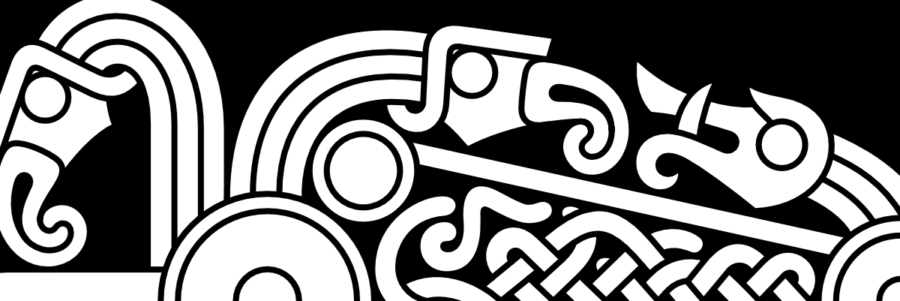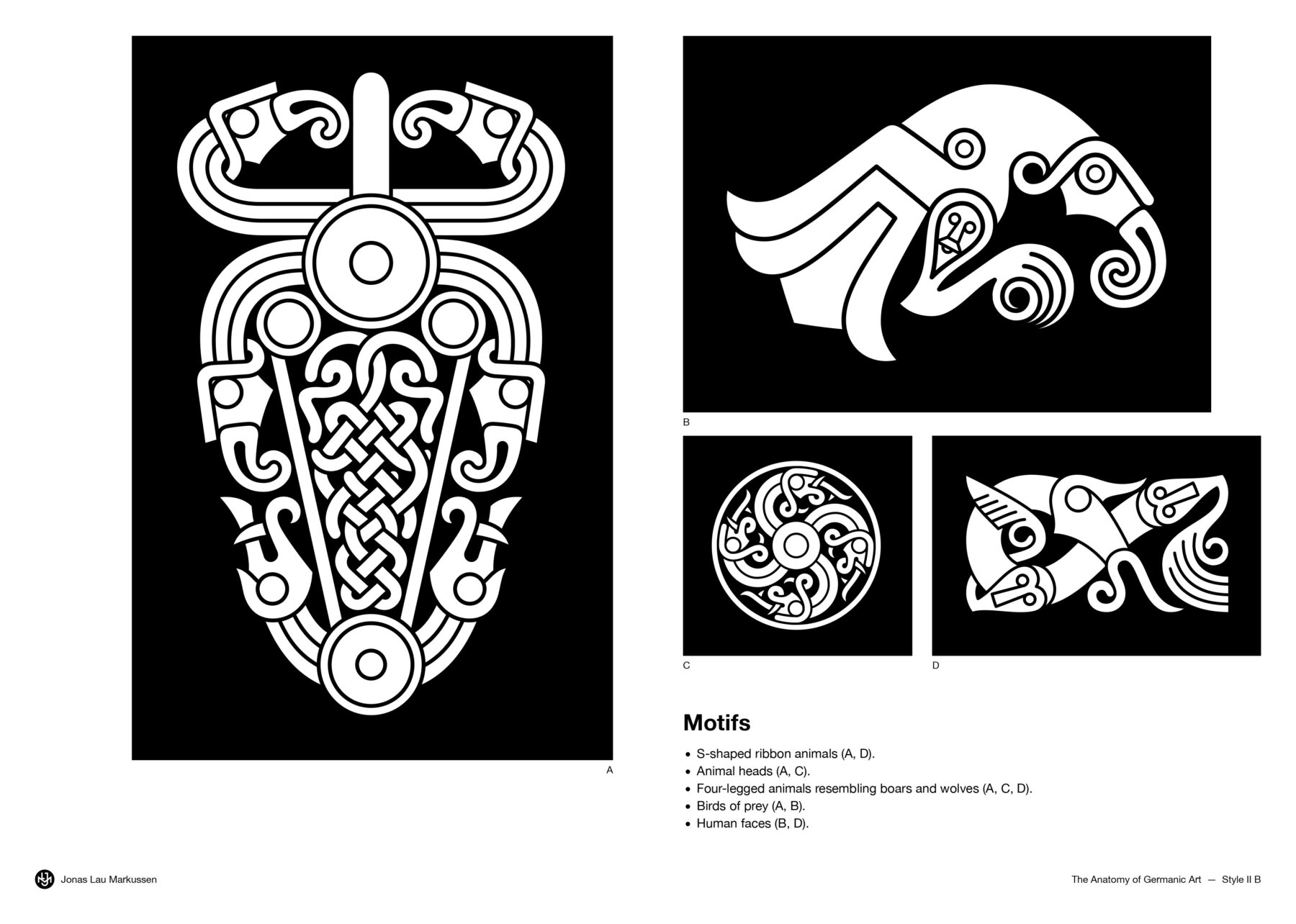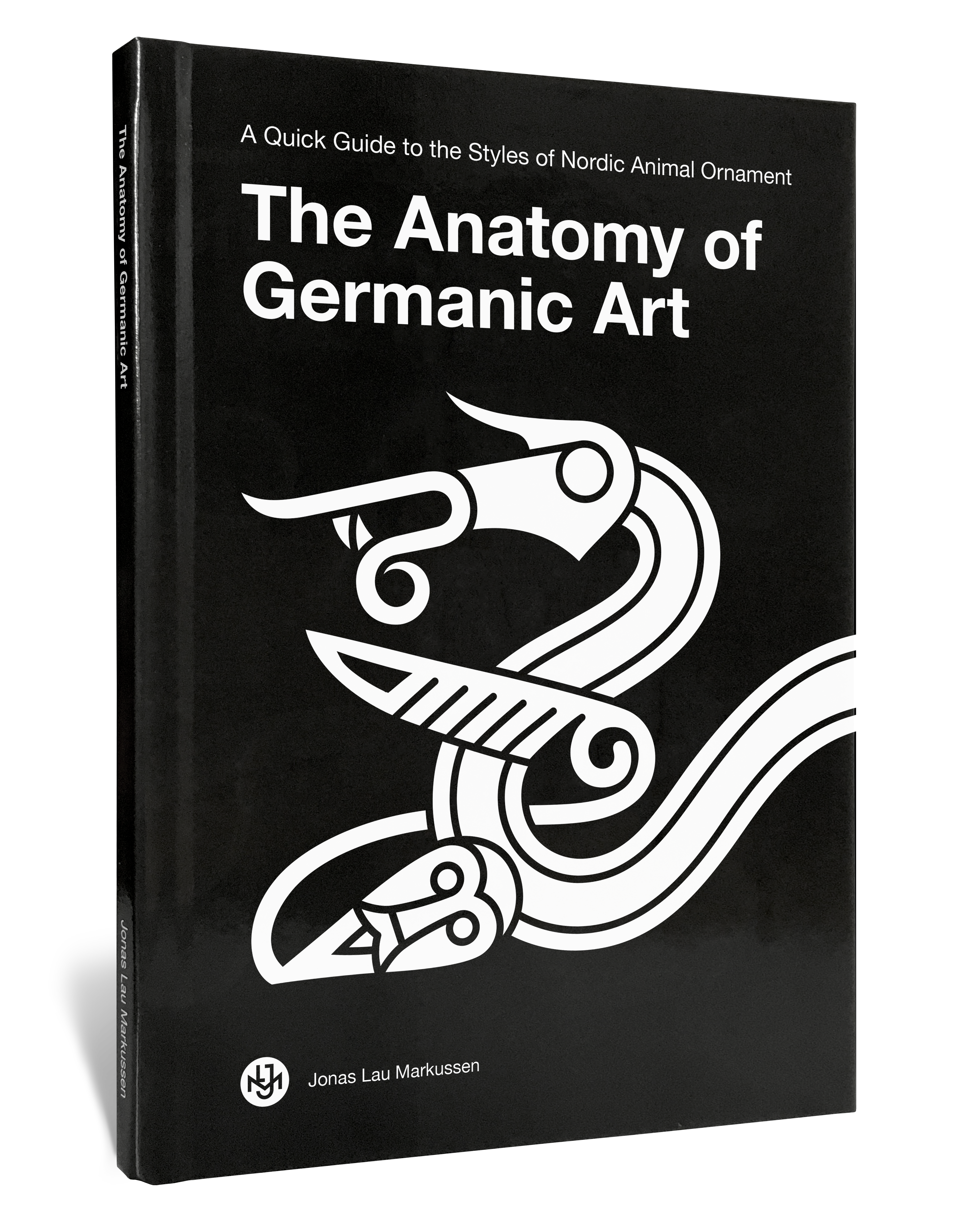
Style II/B
July 18, 2018
The Anatomy of Germanic Art
- Introduction
- Early Animal Style
- Style I
- Style II/B
- Style II/C
- Style II/D
The Anatomy of Style II/B
c. 550 – 650
Shapes
1. Spirals.
2. Animal heads in profile.
3. Human heads facing forward (inside hips).
4. Eyebrow bow framing the eye.
5. Round Eyes.
6. Long straight or curling jaws.
7. Teeth occur.
8. Pointy chin.
9. Head lappet.
10. Almond-shaped hips.
11. Feather-like feet.
12. Curled-up spiral back-toes.
Outlines
Even outlines without tapering or indents.
Flow
A preference for geometric curves.
A. S-shapes.
B. Single loops.
C. Figure-of-eights loops.
Pattern
- Tight interlace with little visible background.
- Single-stranded ribbons.
- Double-stranded ribbons.
- Triple-stranded ribbons.
- Even textile-like interlace patterns.
Composition
- Clear and simple compositions of animal and human figures juxtaposed with geometry and occasional interlacing patterns.
- Compositions based on line-symmetrical S-shapes (A).
- Compositions based on 2-fold rotational-symmetrical S-shapes (D).
- Triskellion or swastika compositions of 3-fold and 4-fold rotational-symmetrical animal heads (D).
Motifs
- S-shaped ribbon animals (A, D).
- Animal heads (A, C).
- Four-legged animals resembling boars and wolves (A, C, D).
- Birds of prey (A, B).
- Human faces (B, D).
The Mighty Winter
The End of the World
In the annals of history, a year stands out as the bleakest of all: 536. It was a time when the world seemed to shiver under the weight of natural calamities. The sun’s warmth waned, and the air turned cold, casting a pall over the land. The Völuspá describes a similar scenario leading up to Ragnarök and the world’s end, the Fimbulvetr (‘mighty winter’), probably inspired by these real-life events. The mighty winter began with a cataclysmic event, possibly triggered by the volcanic eruption of Katla in Iceland. Regardless of the cause, the consequences were dire. Up to 14 years of frigid temperatures followed, devastating crops, livestock, and human populations. The Plague of Justinian, which had already ravaged Europe, intensified during this period. Between 540 and 700, Europe’s population plummeted by 50%. Death stalked the land, leaving behind empty villages and abandoned fields. One of the many consequences of this catastrophe was the vast number of gold offerings in Scandinavia. Perhaps desperate people sought solace in these precious metals, hoping they could appease the gods and bring an end to their suffering.
The Lombards Conquer Italy
In 568, the Lombards, a Germanic people originating from the Elbe region, conquered Italy. Their victory marked the end of the Migration Period and signalled a new chapter in European history.
The English Kingdoms
Christianity made a resurgence in Britain. Missionaries from Rome, led by Augustine, reintroduced the faith. The island’s spiritual landscape shifted, intertwining old pagan beliefs with the teachings of Christ. At Sutton Hoo, a burial mound revealed the remains of a man who must have been a king. Some speculate that this was King Raedwald of East Anglia, who died around 624. His grave contained treasures fit for a ruler, including a magnificent ship burial.
The Avar Khaganate
In the East, the Avar Khaganate emerged in 567. These nomadic warriors challenged the Eastern Roman Empire, asserting their dominance in the vast steppes of Eurasia. Their influence would shape the geopolitics of the region for centuries to come.
Scandinavia
In this period, a remarkable estate was established near the shoreline of Tissø, Sjælland, Denmark. Its central feature was a massive hall building, measuring around 550 square meters in length, a testament to the magnate’s influence. Inside the estate’s precinct was also a small temple reminiscent of similar structures found at Uppåkra and Erritsø, as well as a forge. At Høj Stene, near Vejerslev, Jylland, a giant stone ship is only surpassed by the one raised later at Jelling.
The Elusive Ribbon Animal Emerges
Development
While there are hints of innovation and experimentation in the shape and use of animal bodies in Style I, the shapeshiftiness of Nordic animal ornament really takes shape in Style II/B. The first knotwork patterns, as we know them, emerge, and with them, the iconic ribbon animal. The knotwork patterns exclusively comprise equal-width ribbons, usually interlaced uniformly in diagonal weaving lines, creating a textile-like texture. However, the knotwork patterns can also behave more randomly, resembling a bowl of spaghetti weaving in and out of each other more organically and randomly. Animal heads usually feature prominently in various sizes, either as the heads of ribbon animals or as loose heads without bodies. A common feature is two animal heads in profile, creating an ambiguous image by mirroring each other along the top line of the heads. Together, they compose a third animal head seen in front. This third animal head can sometimes even resemble a man’s bearded face, underscoring the ultimate shape-shifting potential.
Bird-shaped Brooches
A characteristic motif of this style is the many bird-shaped brooches. The birds are clearly birds of prey with huge spiral beaks and large talons. Their bodies and heads are seen in profile, and a bearded man’s face is sometimes fitted into their almond-shaped hip.
Disc-on-bow Brooches and Buckles
Brooches and belt buckles with mirroring pairs of animal heads are common. The heads are most often birds of prey with spiral beaks, but other types of animals occur.
Sutton Hoo Grave and Staffordshire Hoard
The Sutton Hoo grave is probably one of the best exemplifications of Style II/B. The variation and quality of the goods represented collectively here are unmatched outside of the Vendel and Valsgärde sites. The richness is also reflected in the Staffordshire treasure, although it is more fragmentary.
Ring Swords and Animal-shaped Pommels
The sword decoration in this style is also exquisite. A notable feature is the animal-shaped sword pommels, like the one from Vesalihati, Finland. They look like crouching animals with bare, grinning teeth, ready to attack.
Examples
Examples on Gelmir.com →
A list of examples with photos, info and links to sources.
Animal-shaped buckle — Eura
Eura, Satakunta, Finland.
Kansallismuseo, Helsinki, KM8811:1.
Animal-shaped buckle — Leväluhta
Leväluhta, Etelä-Pohjanmaan, Finland.
Kansallismuseo, Helsinki, KM2441:3.
Photo: Museovirasto (CC BY).
Animal-shaped buckle — Gulldynt
Gulldynt, Pohjanmaa, Finland.
Kansallismuseo, Helsinki, KM8562:1.
Animal-shaped sword pommel — Gulldynt
Vesalihati, Pirkanmaa, Finland.
Kansallismuseo, Helsinki, KM 3005:6.
Animal-shaped sword pommel — Vesalihati
Gulldynt, Pohjanmaa, Finland.
Kansallismuseo, Helsinki, KM1911:1.
Belt buckle — Åker
Åker, Innlandet, Norway.
Kulturhistorisk Museum, Oslo, C4901.
Belt buckle — Åker
Åker, Innlandet, Norway.
Kulturhistorisk Museum, Oslo, C21406.
Belt buckle — Sutton Hoo
Sutton Hoo, Suffolk, England.
The British Museum, London, 1939,1010.1.
Belt mount — Åker
Åker, Innlandet, Norway.
Kulturhistorisk Museum, Oslo, C21406.
Bird-shaped brooch — Egesløkke
Egesløkkegård, Bornholm, Denmark.
Nationalmuseet, København, C36060.
Bird-shaped brooch — Gärdslösa
Gärdslösa, Öland, Sweden.
Historiska Museet, Stockholm, 371920.
Bird-shaped brooch — Karlshøj
Karlshøj, Bornholm, Denmark.
Nationalmuseet, København, C35752.
Bird-shaped brooch — Myregård
Myregård, Bornholm, Denmark.
Nationalmuseet, København, C35683.
Bird-shaped brooch — Sätra
Sätra, Öland, Sweden.
Historiska Museet, Stockholm, 266710.
Bowl
Vimose, Fyn, Denmark.
Nationalmuseet, København, 24452.
Brooch
Reinstrup, Sjælland, Denmark.
Nationalmuseet, København, DNF4/18.
Buckles
King’s Field, Kent, England.
The British Museum, London, .1094.’70.
Harness mount — Vallstenarum
Vallstenarum, Gotland, Sweden.
Historiska Museet, Stockholm, 362428.
Harness mounts — Sutton Hoo
Sutton Hoo, Suffolk, England.
The British Museum, London, 1991,0411.2871.a-d; 1991,0411.2877; 1991,0411.2880.a; 1991,0411.2880.b; 1991,0411.2881.a; 1991,0411.2881.b; 1991,0411.2882.a; 1991,0411.2882.b; 1991,0411.2885; 1991,0411.2886.c; 1991,0411.2887; 1991,0411.2888.b.
Harness mount
Sutton Hoo, Suffolk, England.
The British Museum, London, 1991,0411.2203.
Harness mount — Vendel, 971412
Vendel, Uppland, Sweden.
Historiska Museet, Stockholm, 971412.
Harness mounts — Vendel, 273531
Vendel, Uppland, Sweden.
Historiska Museet, Stockholm, 273531.
Helmet
Ultuna, Uppland, Sweden.
Historiska Museet, Stockholm, 272256.
Purse lid
Sutton Hoo, Suffolk, England.
The British Museum, London, 1939,1010.2.a-l; 1939,1010.2.a-l.
S-shaped brooch
Englerupgård, Sjælland, Denmark.
Nationalmuseet, København, C36406.
Shield mount — Rolex
Rolex, Gotland, Sweden.
Gotlands Museum, Visby, GFC3641.
Shield mounts
Sutton Hoo, Suffolk, England.
The British Museum, London, 1939,1010.94.
Shield mount — Åker
Åker, Innlandet, Norway.
Kulturhistorisk Museum, Oslo, C4903.
Shoulder clasps
Sutton Hoo, Suffolk, England.
The British Museum, London, 1939,1010.4; 1939,1010.5.
Sword — Sutton Hoo
Sutton Hoo, Suffolk, England.
The British Museum, London, 1939,1010.25; 1939,1010.27; 1939,1010.28; 1939,1010.29; 1939,1010.95.
Sword — Ultuna
Ultuna, Uppland, Sweden.
Historiska Museet, Stockholm, 265030.
Sword — Vendel, 122961
Vendel, Uppland, Sweden.
Historiska Museet, Stockholm, 122961.
Sword — Vendel, 264442
Vendel, Uppland, Sweden.
Historiska Museet, Stockholm, 264442.





